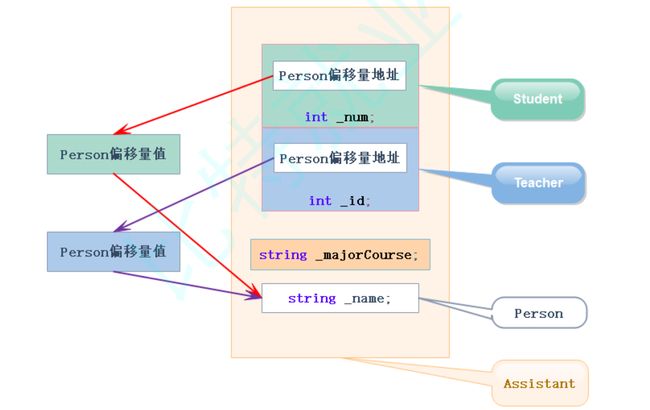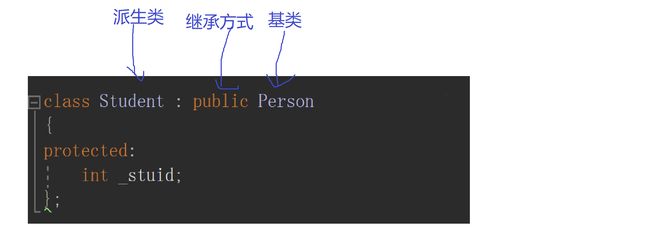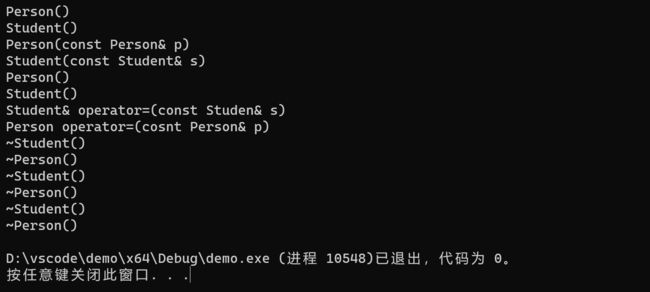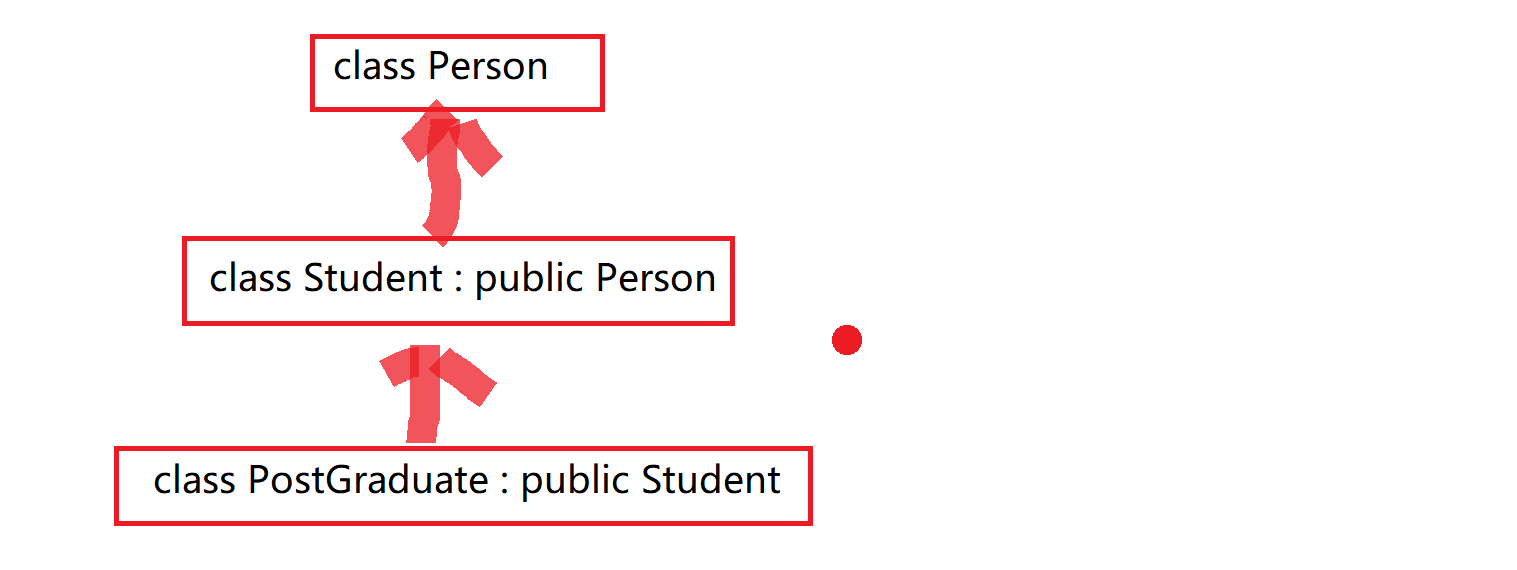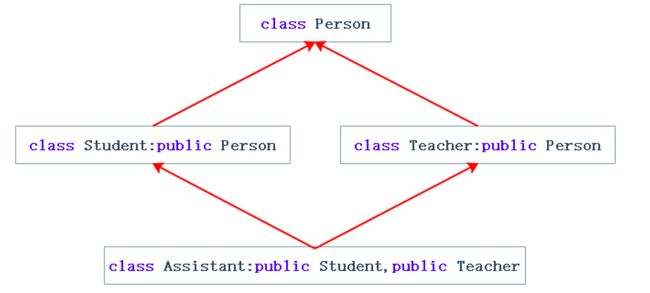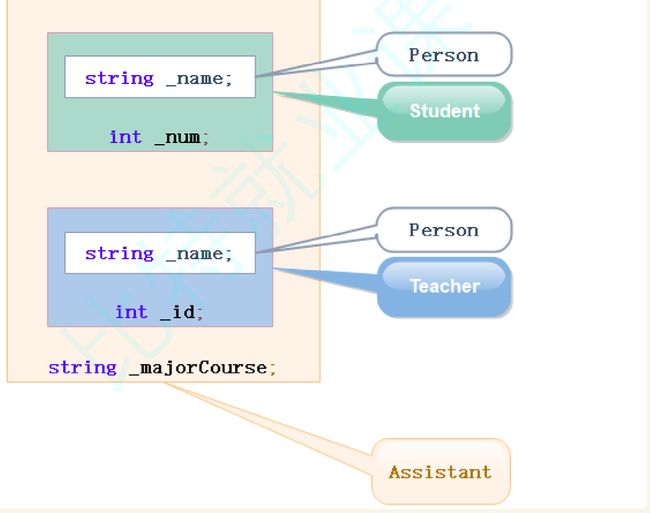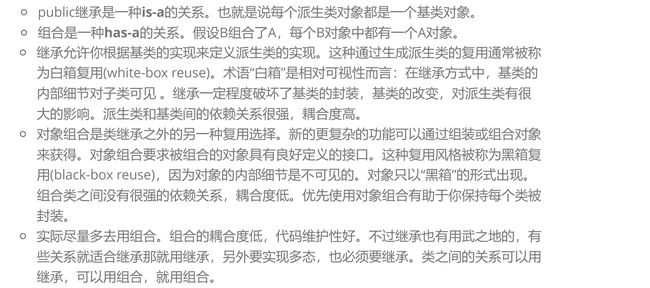【C++】继承
文章目录
- C++中的继承
-
- 1. 继承的概念及定义
-
- 1.1 继承的概念
- 1.2 继承定义
-
- 1.2.1 定义格式
- 1.2.2 继承方式的访问限定符
- 1.2.3 继承基类成员访问方式的变化
- 2. 基类和派生类对象赋值转换
- 3. 继承中作用域
- 4. 派生类的默认成员函数
- 5. 继承与友元
- 6. 继承与静态成员
- 7. 菱形继承及菱形虚拟继承
C++中的继承
1. 继承的概念及定义
1.1 继承的概念
继承机制是面向对象程序设计使代码可以复用的最重要的手段,它允许程序员在保持原有类特性的基础上进行扩展,增加功能,这样产生新的类,称为派生类。继承呈现了面向对象程序设计的层次结构,体现了有简单到复杂认知的过程。之前我们解除的复用都是函数复用,继承是类设计层次的复用
class Person
{
public:
void Print()
{
cout << "name:" << _name << endl;
cout << "age:" << _age << endl;
}
private:
string _name = "zy";
int _age = 12;
};
class Student : public Person
{
protected:
int _stuid;
};
class Teacher : public Person
{
protected:
int _jobid;
};
int main()
{
Student s;
Teacher t;
s.Print();
t.Print();
}
继承后父类的Person的成员(成员函数和成员变量)都会成为子类的一部分。这里体现出了Student和Teacher复用了Person的成员。我们使用监视窗口可以看到变量的复用。调用Print()函数可以看到成员函数的复用
1.2 继承定义
1.2.1 定义格式
我们可以看到Person是父类,我们也可以称为是基类。Student是子类,也可以称为是派生类
1.2.2 继承方式的访问限定符
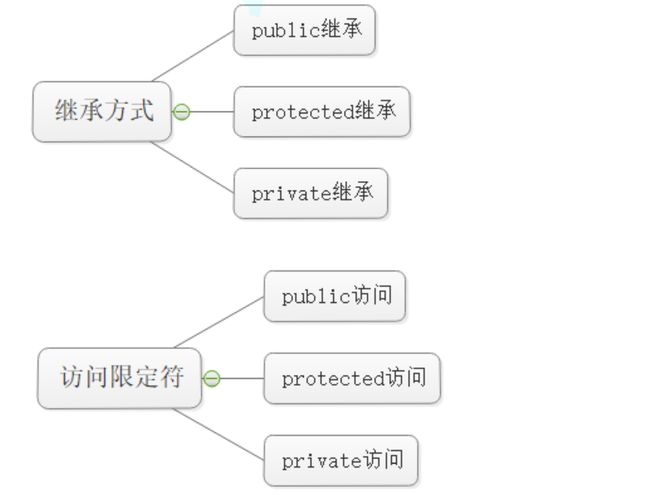
1.2.3 继承基类成员访问方式的变化
| 类成员/继承方式 | public继承 | protected继承 | private继承 |
|---|---|---|---|
| 基类的public成员 | 派生类的pubic成员 | 派生类的protected成员 | 派生类的private成员 |
| 基类的protected成员 | 派生类的protected成员 | 派生类的protected成员 | 派生类的private成员 |
| 基类的private成员 | 在派生类中不可见 | 在派生中不可见 | 在派生类中不可见 |
总结:
- 基类private成员在派生类中无论用什么方式继承都是不可见的。这里的不可见指基类的私有成员被集成到了派生类对象当中,但是语法上限制派生类对象无论在类里面还是类外面都是无法访问的
- 基类private成员在派生类中是不能被访问的,如果基类成员不想再类外被访问,但是需要在派生类中能够被使用,就定义为protected。可以看出保护成员限定符是因为继承才出现的
- 上面的表格总计一下我们就会发现,基类的私有成员在派生类中都是不可见的。基类的其他成员在派生类中的访问方式==MIN(成员在基类的访问限定符,继承方式)public 》 protected 》 private
- 使用关键字class时默认的继承方式是private,使用struct时,默认的继承方式是public,不过最好显式的写出来
- 在实际应用当中一般使用都是public继承,几乎很少使用protected/private继承,也不提倡使用这两种继承方式,因为继承下来的成员都只能在派生类的类里面使用,实际中扩展维护性不强
2. 基类和派生类对象赋值转换
- 派生类对象可以赋值给基类的对象/基类的指针/基类的引用,这里有个形象的说法叫做切片或者切割。寓意是把派生类当中父类那部分切来赋值过去
- 基类对象不能赋值给派生类对象
- 基类的指针或者引用可以通过强制类型转换赋值给派生类的指针或者引用。但是必须是基类的指针指向派生类的对象时才是安全的
class Person
{
protected:
string _name; // 姓名
string _sex; // 性别
int _age; // 年龄
};
class Student : public Person
{
public:
int _No; // 学号
};
void Test()
{
Student sobj;
// 1.子类对象可以赋值给父类对象/指针/引用
Person pobj = sobj;
Person* pp = &sobj;
Person& rp = sobj;
//2.基类对象不能赋值给派生类对象
sobj = pobj;
// 3.基类的指针可以通过强制类型转换赋值给派生类的指针
pp = &sobj;
Student * ps1 = (Student*)pp; // 这种情况转换时可以的。
ps1->_No = 10;
pp = &pobj;
Student* ps2 = (Student*)pp; // 这种情况转换时虽然可以,但是会存在越界访问的问题
ps2->_No = 10;
}
3. 继承中作用域
- 在继承体系当中,基类和父类都有独立的作用域
- 子类和父类当中有同名成员,子类成员将屏蔽父类对同名成员的直接访问,这种情况叫做隐藏,也叫作重定义。(在子类成员函数当中,可以使用基类::基类成员,来进行显示访问)
- 需要注意的是如果是成员函数的隐藏,只需要函数名相同就构成隐藏
- 在实际当中,在继承体系里面最好不要定义同名的成员
class Person
{
protected:
string _name = "zhangsan";
int _num = 111;
};
class Student : public Person
{
public:
void Print()
{
cout << "姓名:" << _name << endl;
cout << "身份证号:" << Person:: _num << endl;
cout << "学号" << _num << endl;
}
protected:
int _num = 999;
};
void Test()
{
Student s;
s.Print();
}
Student和Person的_num 构成隐藏关系,这样的代码虽然可以跑,但是非常乱
class A
{
public:
void fun()
{
cout << "fun()" << endl;
}
};
class B : public A
{
public:
void fun(int i)
{
A::fun();
cout << "fun(int i)" << endl;
}
};
void Test()
{
B b;
b.fun(1);
}
// B中的fun和A中的fun不是构成重载,因为不是在同一作用域
// B中的fun和A中的fun构成隐藏,成员函数满足函数名相同就构成隐藏。
4. 派生类的默认成员函数
6个默认成员函数,“默认”的意思就是指我们不写,编译器就会自动生成一个,在派生类中这几个成员函数是怎么生成的呢?
- 派生类的构造函数必须调用基类的构造函数初始化基类的那一部分成员。如果基类没有默认的构造函数,则必须在派生类构造函数的列表阶段显示调用
- 派生类的拷贝构造函数必须调用基类的拷贝构造函数完成基类的拷贝初始化
- 派生类的operator=必须调用基类的operator=完成基类的复制
- 派生类的析构函数会在被调用完成之后自动调用基类的析构函数清理基类成员,只有这样才能保证派生类对象先清理派生类成员再清理基类成员的顺序
- 派生类对象初始化先调用基类构造再调用派生类构造
- 派生类对象析构清理,先调用派生类析构再调用基类析构
- 后续一些场景需要析构函数的重写,重写的条件之一是函数名相同。编译器会对析构函数名进行特殊处理,处理成
destructro(),所以父类析构不加virtual的情况下,子类析构和父类析构函数构成隐藏关系
class Person
{
public:
Person(const char* name = "zhangsan")
:_name(name)
{
cout << "Person()" << endl;
}
Person(const Person& p)
:_name(p._name)
{
cout << "Person(const Person& p)" << endl;
}
Person& operator=(const Person& p)
{
cout << "Person operator=(cosnt Person& p)" << endl;
if (this != &p)
{
_name = p._name;
}
return *this;
}
~Person()
{
cout << "~Person()" << endl;
}
protected:
string _name;
};
class Student : public Person
{
public:
Student(const char* name, int num)
: Person(name)
, _num(num)
{
cout << "Student()" << endl;
}
Student(const Student& s)
: Person(s)
, _num(s._num)
{
cout << "Student(const Student& s)" << endl;
}
Student& operator=(const Student& s)
{
cout << "Student& operator=(const Studen& s)" << endl;
if (this != &s)
{
Person::operator=(s);
_num = s._num;
}
return *this;
}
~Student()
{
cout << "~Student()" << endl;
}
protected:
int _num;
};
int main()
{
Student s("jack", 18);
Student s2(s);
Student s3("rose", 13);
s = s3;
}
运行结果如下所示:
5. 继承与友元
友元关系不能被继承,也就是说基类友元不能访问子类私有和保护成员
class Student;
class Person
{
public:
friend void Display(const Person& p, const Student& s);
protected:
string _name; // 姓名
};
class Student : public Person
{
protected:
int _stuNum; // 学号
};
void Display(const Person& p, const Student& s)
{
cout << p._name << endl;
cout << s._stuNum << endl;
}
void main()
{
Person p;
Student s;
Display(p, s);
}
6. 继承与静态成员
基类定义了static静态成员,则整个继承体系里面只有一个这样的成员。无论派生了多少个子类,都只有一个static成员实例
class Person
{
public:
Person()
{
_count++;
}
protected:
string _name;
public:
static int _count;
};
int Person::_count = 0;
class Student : public Person
{
protected:
int _stuNum;
};
class Graduate : public Student
{
protected:
string _seminarCourse;
};
void test()
{
Student s1;
Student s2;
Student s3;
Graduate g;
cout << "人数:" << Person::_count << endl;
Student::_count = 0;
cout << "人数" << Person::_count << endl;
}
7. 菱形继承及菱形虚拟继承
单继承:一个子类只有一个直接父类的时候,称这个继承关系为单继承
多继承:一个子类有两个或者两个以上直接父类称这个继承关系为多继承
菱形继承:菱形继承是多继承的一个特殊情况
菱形继承的问题:从下面的成员对象模型,可以看出菱形继承有数据冗余和二义性的问题
在Assiatant的对象当中Person成员会存在两份
class Person
{
public:
string _name; // 姓名
};
class Student : public Person
{
protected:
int _num; //学号
};
class Teacher : public Person
{
protected:
int _id; // 职工编号
};
class Assistant : public Student, public Teacher
{
protected:
string _majorCourse; // 主修课程
};
void Test()
{
// 这样会有二义性无法明确知道访问的是哪一个
Assistant a;
a._name = "peter";
// 需要显示指定访问哪个父类的成员可以解决二义性问题,但是数据冗余问题无法解决
a.Student::_name = "xxx";
a.Teacher::_name = "yyy";
}
虚继承可以解决菱形继承的二义性和数据冗余性的问题。如上面的继承关系,在Student和Teacher继承Person时使用虚拟继承,即可解决问题。需要注意的是:虚拟继承不需要在其他地方使用
class Person
{
public:
string _name; // 姓名
};
class Student : virtual public Person
{
protected:
int _num; //学号
};
class Teacher : virtual public Person
{
protected:
int _id; // 职工编号
};
class Assistant : public Student, public Teacher
{
protected:
string _majorCourse; // 主修课程
};
void Test()
{
Assistant a;
a._name = "peter";
}
虚拟继承解决数据冗余和二义性的原理
为了研究虚拟继承的原理,借助内存窗口观察成员的模型
class A
{
public:
int _a;
};
// class B : public A
class B : virtual public A
{
public:
int _b;
};
// class C : public A
class C : virtual public A
{
public:
int _c;
};
class D : public B, public C
{
public:
int _d;
};
int main()
{
D d;
d.B::_a = 1;
d.C::_a = 2;
d._b = 3;
d._c = 4;
d._d = 5;
return 0;
}
这里通过了B和C两个指针,指向一张表。这两个指针叫做虚基指针,这两个表叫做虚基表。虚基表中存的是偏移量。通过偏移量可以找到A
